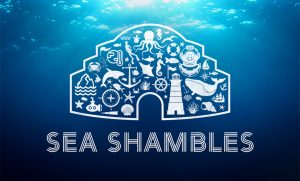Brine Rejection
Sea Shambles Advent Calendar - Day 3December 3rd
This bright pink hedgehog-like thing may appear to be a long way down the hierarchy of ocean-related wonder, but I think that it deserves its place in our sea-celebration.

This is one of my photos, taken on a ship in the Arctic in 2012. It’s here because i) I love the way it looks and ii) it demonstrates an extremely important ocean process: the way in which the ocean can make itself saltier.
I never intended to end up with a pink hedgehog. Some of the researchers on the ship were using a super-pink dye called rhodamine in their experiments, and I wanted to demonstrate something about the process of ice melting. So I was given permission to take some rhodamine to make a large pink ice cube. If you’ve never met rhodamine, the thing you need to know about it is that it’s the pinkest substance you can possibly image. A tiny amount of it can dye a significant portion of the ocean very pink (really), although it’s non-toxic and degrades very quickly in sunlight so the pink doesn’t last long. The critical information in that statement is that it only takes a tiny amount to do that. I filled a small plastic container with rhodamine on the back deck of the ship and set off to the freezers, down in the hold. I was just passing the galley (the kitchen) when one of the deck hands reached me, turned me around, presented me with a bucket and a scrubbing brush, and we re-traced my steps to the back deck. This wasn’t hard, because my container had been leaking ever so slightly, leaving a cheerful trail of pink splotches and footprints all the way across the deck and down the stairs. Half an hour of scrubbing converted the splotches from fuchsia to rose-tinted, and then I was allowed back downstairs with my now triple-wrapped container. I used it to dye a pot of water, stashed that in the freezer and went back upstairs to endure two days of rose-tinted teasing and a blushing back deck.
When I retrieved my pot from the freezer, what I found is what’s in the photo. Instead of a uniformly pink ice cylinder, I had a spiky ball of pink encased in perfectly colourless ice. It was useless for my planned demonstration, but perfect for highlighting something else.
The Cosmic Shambles Network relies on your support on pledges via Patreon so we can continue to provide great, new, exciting content without the need for third party ads or paywalls.
For as little as $1 a month you can support what we do and get some great rewards for doing so as well. Click the Patreon logo to pledge or find out more.
When water freezes, mobile molecules that were constantly dancing around each other in the liquid have to lock themselves down into a regular arrangement: a crystal. There isn’t room in that crystal structure for anything that isn’t the right shape, and the only right shape is that of a water molecule. So anything that’s dissolved in the water just stays in the liquid, while the water molecules gradually lock themselves into crystal form, shoving the intruders out as they freeze. This is what happened here – the pot was coldest on the outside, so the outer water molecules froze first, squeezing the pink dye into the middle. The spikes are actually tubes: channels of ever-more concentrated liquid that provided the pink dye with a route out of the ice. In the middle, the dye solution got more and more concentrated until at last the water and dye had to find a way to freeze together, forming a slushy pink mixture of almost-ice.
When sea ice forms in the Arctic and Antarctic, the surface of the ocean freezes and exactly the same process happens. But what’s rejected from the ice isn’t pink dye – it’s salt. The ocean is incredibly salty, and the water just beneath freezing sea ice becomes even saltier as the super-salty brine rejected by the freezing ice mixes with the liquid water just below. The ocean is making itself saltier, wherever this happens. It matters because saltier water is more dense, and so the dense salty water sinks downward into the ocean beneath. In the same way that a candle heats the air above it and causes a rising plume of hot air, new sea ice causes a downward plume of salty water. This water sinks a long way, often all the way down to the seafloor, and then slithers along the ocean deep for many hundreds of years. We can’t see it directly, because it’s not pretty pink, but it’s a critical process inside the ocean, helping to move huge amounts of water around the planet.
And if you need a game to play over the festive break, give it a try yourself! The result will depend a bit on the dye and the freezer temperature, but do tweet us a picture if you get a particularly pretty result.
This picture was from Dr Helen Czerski, posted on Twitter back when we first asked people for the sea pictures.
See what lies behind all the windows of the Sea Shambles Advent here.
 Sea Shambles is a one night only live extravaganza celebrating the oceans. Hosted by Robin Ince and Helen Czerski with Steve Backshall, British Sea Power, Josie Long, Lemn Sissay and more it’s a night of science, comedy, music, lasers and more in which we’ll be turning the Royal Albert Hall into an underwater playground the likes of which you’ve never seen! May 17 2020. Tickets start at just £10! Book here.
Sea Shambles is a one night only live extravaganza celebrating the oceans. Hosted by Robin Ince and Helen Czerski with Steve Backshall, British Sea Power, Josie Long, Lemn Sissay and more it’s a night of science, comedy, music, lasers and more in which we’ll be turning the Royal Albert Hall into an underwater playground the likes of which you’ve never seen! May 17 2020. Tickets start at just £10! Book here.
 Dr Helen Czerski is a physicist, first and foremost, but she’s acquired a few other labels along the way: oceanographer, presenter, author and bubble enthusiast. A regular on The Cosmic Shambles Network, she has also presented a number of acclaimed documentaries for the BBC and Fully Charged. Recently she was awarded the prestigious William Thomson, Lord Kelvin Medal and Prize from the Institute of Physics.
Dr Helen Czerski is a physicist, first and foremost, but she’s acquired a few other labels along the way: oceanographer, presenter, author and bubble enthusiast. A regular on The Cosmic Shambles Network, she has also presented a number of acclaimed documentaries for the BBC and Fully Charged. Recently she was awarded the prestigious William Thomson, Lord Kelvin Medal and Prize from the Institute of Physics.
If you would like to reuse this content please contact us for details
Subscribe to The Cosmic Shambles Network Mailing list here.
The Cosmic Shambles Network relies on your support on pledges via Patreon so we can continue to provide great, new, exciting content without the need for third party ads or paywalls.
For as little as $1 a month you can support what we do and get some great rewards for doing so as well. Click the Patreon logo to pledge or find out more.


Re escape of highly concentrated material :
We once had a bottle of Methyl Mercaptan (used to give odour to natural gas) found in a fume cupboard & needing disposal . It was double bagged, sealed in a tin & placed in an outside store room. Within 10 minutes people where coming in reporting a smell of gas!
It wasn’t escaping from the bottle but rather the person who’d packed it had handled the bottle & outer tin with the same gloves & those very few molecules where enough to be detected by noses along the whole length of it’s travel through the building.
Amazing stuff.